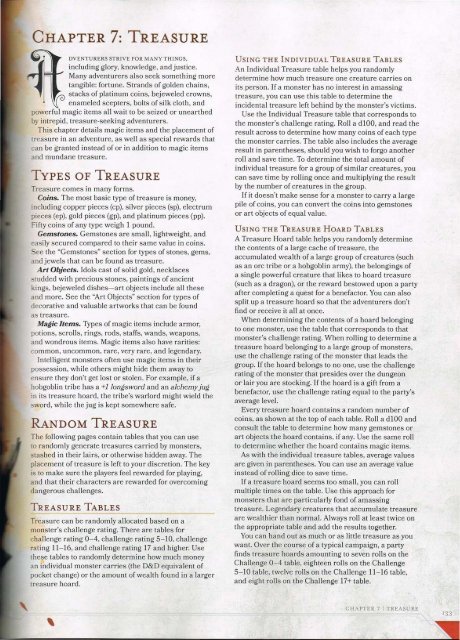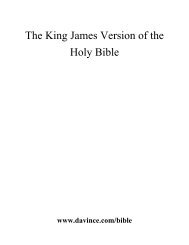Dungeon Master's Guide
Create successful ePaper yourself
Turn your PDF publications into a flip-book with our unique Google optimized e-Paper software.
CHAPTER 7: TREASURE<br />
DVENTURERS STRIVE FOR MANY THINGS,<br />
including glory, knowledge, and justice.<br />
Many adventurers also seek something more<br />
tangible: fortune. Strands of golden chains,<br />
stacks of platinum coins, bejeweled crowns,<br />
enameled scepters, bolts of silk cloth, and<br />
powerful magic items all wait to be seized or unearthed<br />
by intrepid, treasure-seeking adventurers.<br />
This chapter details magic items and the placement of<br />
treasure in an adventure, as well as special rewards that<br />
can be granted instead of or in addition to magic items<br />
and mundane treasure.<br />
TYPES OF TREASURE<br />
Treasure comes in many forms.<br />
Coins. The most basic type of treasure is money,<br />
including copper pieces (cp), silver pieces (sp), electrum<br />
pieces (ep), gold pieces (gp), and platinum pieces (pp).<br />
Fifty coins of any type weigh 1 pound.<br />
Gemstones. Gemstones are small, lightweight, and<br />
easily secured compared to their same value in coins.<br />
ee the "Gemstones" section for types of stones, gems,<br />
and jewels that can be found as treasure.<br />
Art Objects. Idols cast of solid gold, necklaces<br />
tudded with precious stones, paintings of ancient<br />
kings, bejeweled dishes- art objects include all these<br />
and more. See the "Art Objects" sectiori for types of<br />
decorative and valuable artworks that can be found<br />
as treasure.<br />
Magic Items. Types of magic items include armor,<br />
potions , scrolls, rings, rods, staffs, wands, weapons,<br />
and wondrous items. Magic items also have rarities:<br />
common, uncommon, rare, very rare, and legendary.<br />
Intelligent monsters often use magic items in their<br />
possession, while others might hide them away to<br />
ensure they don't get lost or stolen. For example, if a<br />
hobgoblin tribe has a +llongsword and an alchemy jug<br />
in its treasure hoard, the tribe's warlord might wield the<br />
word , while the jug is kept somewhere safe.<br />
RANDOM TREASURE<br />
The following pages contain tables that you can use<br />
to randomly generate treasures carried by monsters,<br />
tashed in their lairs, or otherwise hidden away. The<br />
placement of treasure is left to your discretion. The key<br />
is to make sure the players feel rewarded for playing,<br />
and that their characters are rewarded for overcoming<br />
dangerous challenges.<br />
TREASURE TABLES<br />
Treasure can be randomly allocated based on a<br />
monster's challenge rating. There are tables for<br />
challenge rating 0- 4, challenge rating 5- 10, challenge<br />
rating 11- 16, and challenge rating 17 and higher. Use<br />
these tables to randomly determine how much money<br />
an individual monster carries (the D&D equivalent of<br />
pocket change) or the amount of wealth found in a larger<br />
treasure hoard.<br />
USING THE INDIVIDUA L TREASURE TABLES<br />
An Individual Treasure table helps you randomly<br />
determine how much treasure one creature carries on<br />
its person. If a monster has no interest in amassing<br />
treasure, you can use this table to determine the<br />
incidental treasure left behind by the monster's victims.<br />
Use the Individual Treasure table that corresponds to<br />
the monster's challenge rating. Roll a dlOO, and read the<br />
result across to determine how many coins of each type<br />
the monster carries. The table also includes the average<br />
result in parentheses, should you wish to forgo another<br />
roll and save time. To determine the total amount of<br />
individual treasure for a group of similar creatures, you<br />
can save time by rolling once and multiplying the result<br />
by the number of creatures in the group.<br />
If it doesn't make sense for a monster to carry a large<br />
pile of coins, you can convert the coins into gemstones<br />
or art objects of equal value.<br />
USING THE TREASURE HOARD TABLES<br />
A Treasure Hoard table helps you randomly determine<br />
the contents of a large cache of treasure, the<br />
accumulated wealth of a large group of creatures (such<br />
as an ore tribe or a hobgoblin army), the belongings of<br />
a single powerful creature that likes to hoard treasure<br />
(such as a dragon), or the reward bestowed upon a party<br />
after completing a quest for a benefactor. You can also<br />
split up a treasure hoard so that the adventurers don't<br />
find or receive it all at once.<br />
When determining the contents of a hoard belonging<br />
to one monster, use the table that corresponds to that<br />
monster's challenge rating. When rolling to determine a<br />
treasure hoard belonging to a large group of monsters,<br />
use the challenge rating of the monster that leads the<br />
group. If the hoard belongs to no one, use the challenge<br />
rating of the monster that presides over the dungeon<br />
or lair you are stocking. If the hoard is a gift from a<br />
benefactor, use the challenge rating equal to the party's<br />
average level.<br />
Every treasure hoard contains a random number of<br />
coins, as shown at the top of each table. Roll a dlOO and<br />
consult the table to determine how many gemstones or<br />
art objects the hoard contains, if any. Use the same roll<br />
to determine whether the hoard contains magic items.<br />
As with the individual treasure tables, average values<br />
are given in parentheses. You can use an average value<br />
instead of rolling dice to save time.<br />
If a treasure hoard seems too small, you can roll<br />
multiple times on the table. Use this approach for<br />
monsters that are particularly fond of amassing<br />
treasure. Legendary creatures that accumulate treasure<br />
are wealthier than normal. Always roll at least twice on<br />
the appropriate table and add the results together.<br />
You can hand out as much or as little treasure as you<br />
want. Over the course of a typical campaign, a party<br />
finds treasure hoards amounting to seven rolls on the<br />
Challenge 0- 4 table, eighteen rolls on the Challenge<br />
5- 10 table, twelve rolls on the Challenge 11- 16 table,<br />
and eight rolls on the Challenge 17+ table.<br />
CHAPTER 7 I TREASURE<br />
133




